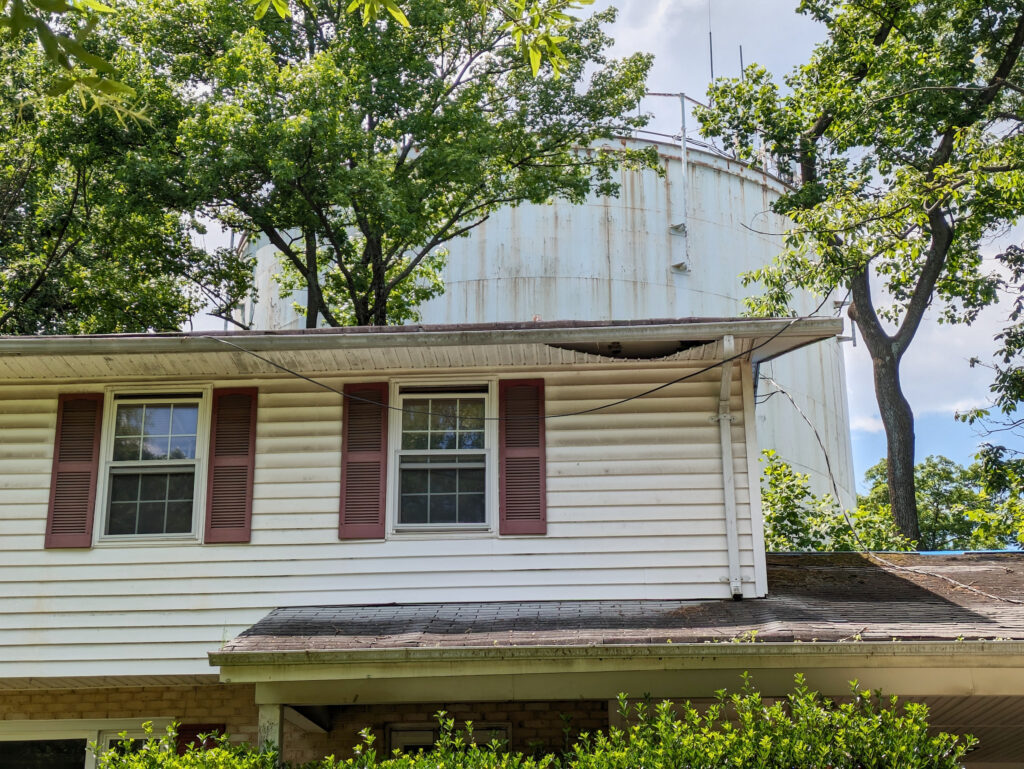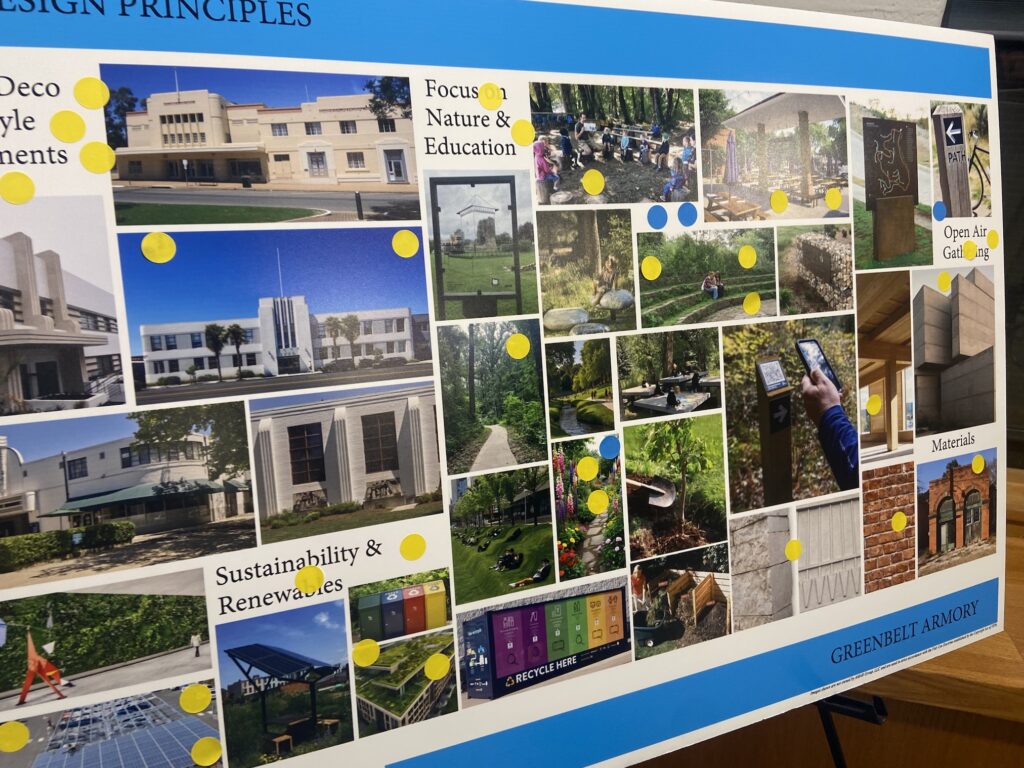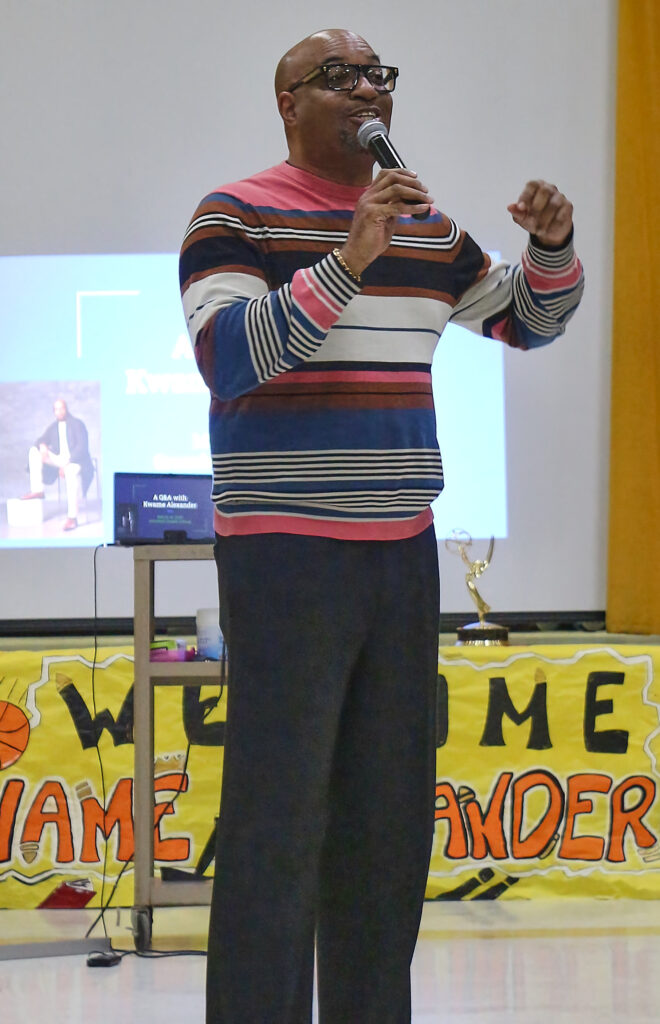The entire Greenbelt City Council met with representatives of WSSC on May 20 in a second worksession concerning updates to the WSSC Standpipe Rehabilitation Project. Safety and environmental concerns dominated the discussion. The first worksession about the project took place on October 30, 2023 (see the November 16, 2023, issue).
The standpipe, commonly called a water tower, is located at the corner of Ridge Road and Lastner Lane. Constructed in 1936, the standpipe is on one of the highest points in Prince George’s County. WSSC’s standpipes serve as emergency sources of water and all are located in elevated areas throughout the county.
WSSC Project Manager Christopher DeHerde provided most of the information, assisted by a project outreach manager, government affairs manager and customer advocates in attendance. WSSC staff had met with the Advisory Planning Board (APB) days prior to the worksession.
In order to easily access and rehabilitate the standpipe, WSSC has purchased the house at 241 Lastner Lane. DeHerde explained that rodents, vandalism and roof leaks have damaged the house. WSSC contacted Community Forklift to offer any usable components of the house but only a few were deemed salvageable, even, in response to Councilmember Kristen Weaver’s question, the retaining wall on the property. DeHerde noted that the Greenbelt Volunteer Fire Department has contacted WSSC to discuss using the property for training purposes. In the demolition plan, the house, three sheds and a small parking lot on the property will be removed. An underground altitude valve, which operates on demand, and its piping will also be removed as they are at the end of their useful life. The existing driveway will be removed but the apron will be retained. Terri Hruby, director of Planning and Community Development, encouraged WSSC to bring the driveway up to commercial standards.
In the current site plan for the project, DeHerde explained, the existing fence will be set back about 25 to 30 feet from Lastner Lane. Councilmember Rodney Roberts objected, saying the fencing would be an “intrusion” into a residential neighborhood, but it was pointed out that the area is already fenced on three sides for security purposes and that immediate neighbors have agreed with WSSC’s suggested fence line. The proposed fence will be eight feet tall and have a black PVC coating. There will not be exterior lighting nor security cameras. The fence will have one access point that will be locked. The proposed landscaping plan includes 52 plantings of a mix of holly, arborvitae and birch to provide screening for the fence.
A pollinator garden has been proposed but may be reduced in size or eliminated if its cost becomes prohibitive. Mayor Emmett Jordan asked which entity would be responsible for the maintenance of the plantings, and DeHerde replied that WSSC would maintain the area. A resident of Julian Court requested that trees be placed on the back and side of the WSSC property to screen the view of the fence, and DeHerde stated he would look into the possibility and adjust the plan accordingly. Councilmember Silke Pope requested that the city arborist be consulted about the plantings. Monica Marquina, government affairs manager, agreed to contact the city horticulture staff.
Structural Integrity, Painting
Structural upgrades to the standpipe itself include improvements in railings and additional safety measures for workers in accordance with Occupational Safety and Health Administration (OSHA) requirements, replacing the altitude valve and its piping, repairing the foundation of the standpipe which is chipped in places, adding structural steel upgrades and applying an epoxy coating after an abrasive blasting to remove rust. Roberts asked about the structural integrity of the standpipe. DeHerde responded that it was inspected and evaluated at the beginning of the project and, while there is some corrosion and rust present as the standpipe had not been coated in more than 20 years, he assured council it is structurally sound and can be repaired to be “as good as new.” Roberts asked how long the standpipe can last. If it is properly maintained with periodic coating, it can last indefinitely, DeHerde replied. City Manager Josué Salmerón asked when the standpipe was last drained and the interior resurfaced and was told it was also 20 years or more ago.
The decorative painting of the rehabilitated standpipe was a less serious topic. Four options were presented by WSSC: its standard blue color, a light green fading to a dark green at the top, a dark green with a lighter green top, or a light green with a band of trees drawn around the top. In her comments, Isabelle Gournay, for the APB, suggested a city logo such as the one used for the city’s 75th anniversary be added. She noted that as an architectural historian, she would like to see a sign explaining the history of the standpipe and why it is an important feature of Greenbelt.
The scope of work was described in the presentation. The project will be prepared for bid this summer. After the contract is awarded, a contractor selected and the plan prepared, DeHerde estimated that work may begin this winter. Demolition of the 241 Lastner Lane structures may then take place in the spring of 2025, and is expected to take up to one month, depending on the weather. The project is estimated to take about 18 months to complete and is expected to be completed in the summer of 2026. During construction, a noise abatement plan will be in place, soil and sediment controls including a silt fence are planned and a dedicated construction entrance will be set up. Deliveries to the site will be arranged outside of school hours, noting the site’s proximity to Greenbelt Elementary School.
Communications
How communications about the project to residents and involved parties will be handled consumed a large part of the discussion. WSSC intends to use mailers to affected residents about the project and will update its webpage frequently. Council will be kept informed of progress. Jordan requested that the News Review be informed so the information may be published. Councilmember Jenni Pompi asked that there be a way for passersby and the wider community to be informed; she was assured that a project sign will be erected at the site. Information also will be disseminated on social media and on the city’s website.
Council reminded WSSC that Metrobuses use Lastner Lane and might be affected by construction. Jordan asked how the city would be notified in case of an emergency at the site and was told the police would be notified first and WSSC will set up a notification system for the appropriate contacts for the city. Councilmember Amy Knesel asked how customers whose water will be shut off during the drainage and rehabilitation of the interior of the standpipe will be notified. This aspect of the project is expected to affect only 10 houses for about eight hours and will be done at night. Doorhangers will be placed at the affected houses 48 hours in advance containing information on how to contact WSSC.
WSSC’s Telecommunications Systems Section Manager Wayne Anderson gave council an update on the telecommunications plan. T-Mobile will be erecting a 110-foot ballasted monopole to replace the equipment that is currently attached to the standpipe. T-Mobile will meet with the city in July and with the Telecommunications Commission in June.
Another lengthy discussion concerned the environmental impacts of the project, particularly the sandblasting of the tank and the possibility of lead paint present in the house or standpipe. DeHerde explained that a containment system will be used to collect dust and debris during the abrasive blasting. WSSC will employ a third-party environmental company to monitor the amount and composition of dust and report any problems to the city and WSSC. Work would be shut down if unacceptable results were found, Marquina noted. Julian Court resident Thomas Zeller expressed his concerns about the possibility of lead exposure but felt “reassured” by the plan for monitoring. Jordan requested that the city be informed of the results of the monitoring.
Jordan ended the worksession by encouraging residents to watch for continuing updates on the project.




